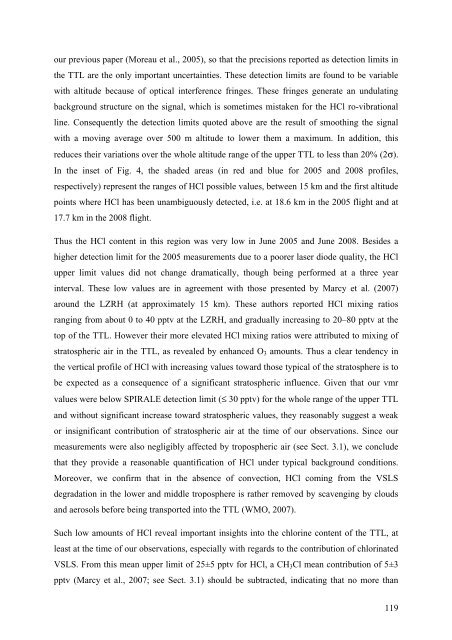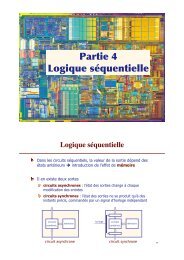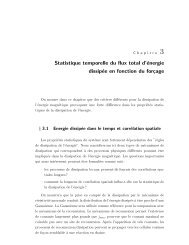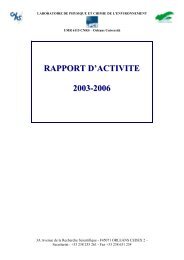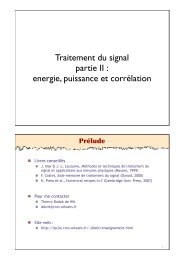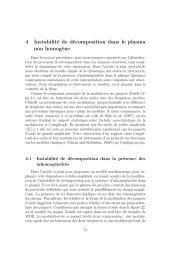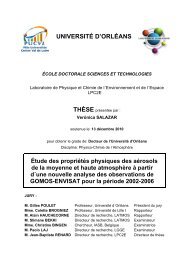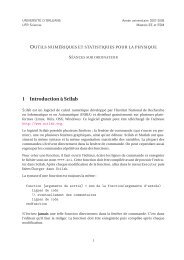UNIVERSITÉ D'ORLÉANS - Laboratoire de physique et chimie de l ...
UNIVERSITÉ D'ORLÉANS - Laboratoire de physique et chimie de l ...
UNIVERSITÉ D'ORLÉANS - Laboratoire de physique et chimie de l ...
You also want an ePaper? Increase the reach of your titles
YUMPU automatically turns print PDFs into web optimized ePapers that Google loves.
our previous paper (Moreau <strong>et</strong> al., 2005), so that the precisions reported as <strong>de</strong>tection limits in<br />
the TTL are the only important uncertainties. These <strong>de</strong>tection limits are found to be variable<br />
with altitu<strong>de</strong> because of optical interference fringes. These fringes generate an undulating<br />
background structure on the signal, which is som<strong>et</strong>imes mistaken for the HCl ro-vibrational<br />
line. Consequently the <strong>de</strong>tection limits quoted above are the result of smoothing the signal<br />
with a moving average over 500 m altitu<strong>de</strong> to lower them a maximum. In addition, this<br />
reduces their variations over the whole altitu<strong>de</strong> range of the upper TTL to less than 20% (2σ).<br />
In the ins<strong>et</strong> of Fig. 4, the sha<strong>de</strong>d areas (in red and blue for 2005 and 2008 profiles,<br />
respectively) represent the ranges of HCl possible values, b<strong>et</strong>ween 15 km and the first altitu<strong>de</strong><br />
points where HCl has been unambiguously <strong>de</strong>tected, i.e. at 18.6 km in the 2005 flight and at<br />
17.7 km in the 2008 flight.<br />
Thus the HCl content in this region was very low in June 2005 and June 2008. Besi<strong>de</strong>s a<br />
higher <strong>de</strong>tection limit for the 2005 measurements due to a poorer laser dio<strong>de</strong> quality, the HCl<br />
upper limit values did not change dramatically, though being performed at a three year<br />
interval. These low values are in agreement with those presented by Marcy <strong>et</strong> al. (2007)<br />
around the LZRH (at approximately 15 km). These authors reported HCl mixing ratios<br />
ranging from about 0 to 40 pptv at the LZRH, and gradually increasing to 20–80 pptv at the<br />
top of the TTL. However their more elevated HCl mixing ratios were attributed to mixing of<br />
stratospheric air in the TTL, as revealed by enhanced O3 amounts. Thus a clear ten<strong>de</strong>ncy in<br />
the vertical profile of HCl with increasing values toward those typical of the stratosphere is to<br />
be expected as a consequence of a significant stratospheric influence. Given that our vmr<br />
values were below SPIRALE <strong>de</strong>tection limit (≤ 30 pptv) for the whole range of the upper TTL<br />
and without significant increase toward stratospheric values, they reasonably suggest a weak<br />
or insignificant contribution of stratospheric air at the time of our observations. Since our<br />
measurements were also negligibly affected by tropospheric air (see Sect. 3.1), we conclu<strong>de</strong><br />
that they provi<strong>de</strong> a reasonable quantification of HCl un<strong>de</strong>r typical background conditions.<br />
Moreover, we confirm that in the absence of convection, HCl coming from the VSLS<br />
<strong>de</strong>gradation in the lower and middle troposphere is rather removed by scavenging by clouds<br />
and aerosols before being transported into the TTL (WMO, 2007).<br />
Such low amounts of HCl reveal important insights into the chlorine content of the TTL, at<br />
least at the time of our observations, especially with regards to the contribution of chlorinated<br />
VSLS. From this mean upper limit of 25±5 pptv for HCl, a CH3Cl mean contribution of 5±3<br />
pptv (Marcy <strong>et</strong> al., 2007; see Sect. 3.1) should be subtracted, indicating that no more than<br />
119


